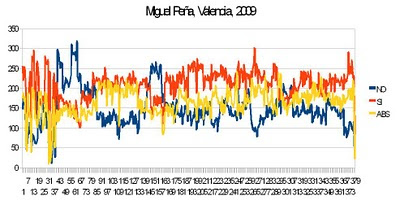First: I know, the charts suck, but I did them on a rush. The important thing is to see the general pattern. You can see how people voted in several key municipios of Carabobo in 2009's referendum. On the Y axis you see number of votes. On the X axis you see a blurry series of all voting centres for that centre. What is interesting is to see the general level of the Sí, the NO and the abstention. The Sí went to Chavismo, the NO to the opposition.
San Diego is represented by the the first chart. San Diego is rather middle class with some slums. There are no nice villas, few rich, most people upgraded social houses. There are lots of university graduates. The have a good mayor, Enzio Scarano. Most Chavistas are contratistas for the national government or very poor squatters who came from Southern Valencia, from the Llanos or from even poorer American countries.

The second chart shows a Northern parish withing the huge Valencia municipality. Most people there are middle to upper middle class.


The next chart shows Miguel Pena, a huge parish that is most of Southern Valencia. It is one of the most dangerous places in America. Most people are poor.

The Naguanagua municipality is mostly anti-Chávez. It is rather middle class, but with quite some variance: a few posh areas and some slums. The mayor is the governor's cousin, part of the Salas-Feo clan. You see some areas where the regime is stronger. They are mostly the slums.
Next you see municipio Libertador (not to mix up with Libertador in Caracas), a very poor region with a horrible prison (Tocuyito) and one of the biggest landfills in Venezuela, an ecologic disaster only people in town feel.
The Electoral Council joined Libertador with Miguel Pena and a couple of minor regions in order to produce one of the most shameless examples of gerrymandering in Venezuela.

Los Guayos is a poor municipality that once was a poor but beautiful town and is now a dirty, dangerous place, chock-a-block with slums from people arriving from everywhere in Venezuela, from Ecuador, Peru and Colombia.


Diego Ibarra is a municipality in the Northwest of Carabobo. It is one of the most pro-Chávez regions.
And the more Chavista region in Carabobo is the municipio Juan José Mora, which is a municipality with one of the highest amount of descendants from slaves is. Several of PDVSA's most important facilities (like El Palito Refinery and petrochemical plants) are there.

Think about this: abstention. Abstention is higher in regions the military regime wants to use to consolidate power. If the alternative forces cared, if they were intelligent, they would invest much more time there.

Think about this: abstention. Abstention is higher in regions the military regime wants to use to consolidate power. If the alternative forces cared, if they were intelligent, they would invest much more time there.
Leopoldo López has been there. El Pollo (Carabobo's governor) is starting to go there (finally). What about the others? When in the last years has "national leader" of Primero Justicia, Borges, been there? When has the UNT leader gone to Carabobo's poor regions?
We need to focus on proposing an alternative Venezuela to the people there. We need to put forward a project for sustainable development to them.
